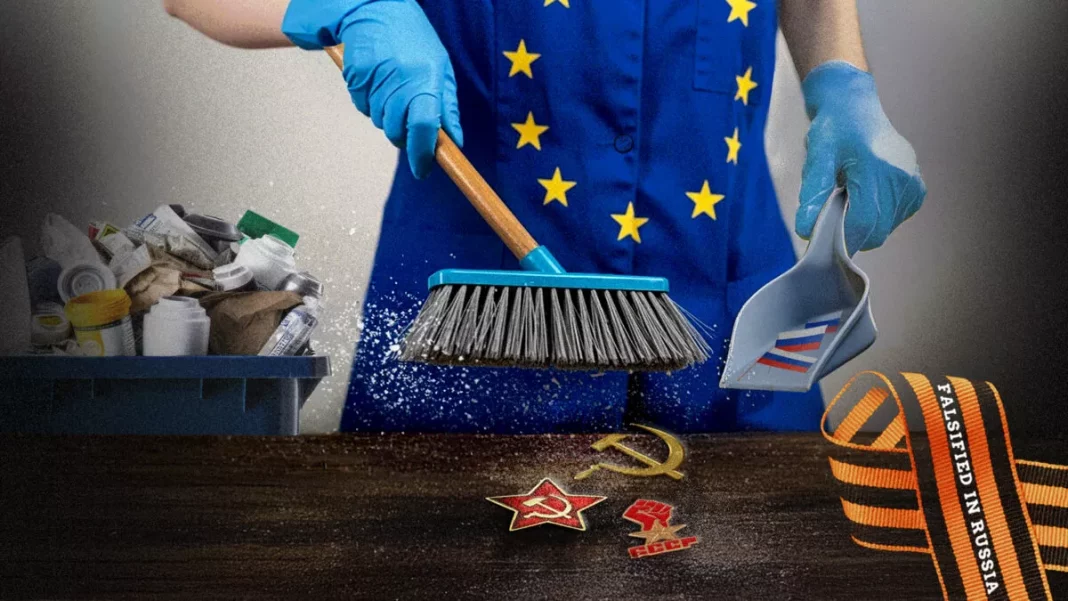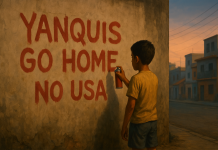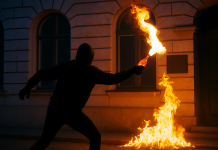By EUvsDisinfo
We continue our examination of the new history books in Russian schools. See the previous article here
The myth of the evil West, always on the verge of attacking, served Soviet leaders well for decades—and it’s back in full force in Putin’s Russia, now at the core of historical revisionism embedded in school history textbooks co-authored and curated by Putin’s aide Vladimir Medinsky, former Minister of Culture-turned-negotiator with Ukraine.
The new history textbooks for grades 10-11 were introduced in 2023. Putin had long spoken of the necessity to revise them, but Russia’s war against Ukraine provided the final push.
Fear of an outside enemy, real or imagined, is one of the oldest and most reliable instruments to unite people and distract them from the problems plaguing their own communities. Let’s have a look at how the idea that the West is an eternal antagonist that repeatedly deceives, threatens, and undermines Russia is officially taught in Russian schools.
War narratives: the foundation of distrust
The narrative of alleged Western betrayal of Russia builds up gradually. In the chapter on the events leading up to World War II, Western democracies are portrayed as deceptive and untrustworthy, blamed for appeasing Hitler and paving the way to his invasion of the USSR. It talks of the “failed strategy” of London and Paris to “stir up conflict between the USSR and Germany”, hinting that the West sought to weaken or destroy Russia. The is manipulation-galore with the aim of removing attention from the important facts and details of the Molotov-Ribbentrop Pact; see our first article.
The conclusion of the World War II chapter becomes the stage to denounce the so-called ingratitude of certain European nations, particularly Poland, Czechoslovakia and the Baltics where many monuments to Soviet soldiers have been removed in later years. Of course, the textbook does not recognize that these monuments were designed to project USSR domination and are bitter reminders of the Soviet occupation that followed. “Desecration and destruction of Soviet monuments means betraying one’s own ancestors”, the textbook declares, arguing that the West’s corruption runs so deep, it has taught entire nations to turn their backs on their own history and identity.
The chapter – effectively capturing the essence of the entire textbook – culminates in a lengthy excerpt from a speech delivered by Vladimir Putin at the May 9 parade in 2023, in which he once again condemns the removal of Soviet monuments in the West, this time also linking it to the war in Ukraine.
Putin’s accusations are just platforms for promoting Moscow’s justification for invading Ukraine: preempting an imagined Ukrainian attack on Russia that never happened.

Western sabotage of the Soviet project
From the end of World War II onward, the textbook attributes nearly every major problem to the actions of the West. The Cold War is blamed entirely on the United States while the Soviet blockade of West Berlin is completely omitted. Moscow’s tightening grip on half of Europe is euphemistically described as “creating a belt of friendly states” along the USSR’s western border. US Ambassador George Kennan’s “Long Telegram”, which analysed and described Stalin’s political system and the Soviet aggression, is presented as a display of unprovoked Western hostility. “The responsibility of Washington and its allies for the start of the confrontation is obvious,” the authors conclude.
As expected, the West is also held responsible for the Soviet Union’s economic struggles and eventual collapse. No word about the dysfunctional design of the Soviet economic model. Western sanctions, the textbook claims, were the primary reason for the USSR’s stagnating economy in the 1980s, because they “sought to block the Soviet Union’s access to advanced technologies and high-tech products”.
Rose-painting the Soviet economic system, with its heavy emphasis on state companies and 5-year plans, is designed to led Russian pupils to accept large state-controlled enterprises as the only natural model for Russia. Accept the Fat-Cat corruption and inefficiently.
In an equally grossly misleading manner, the book portrays Mikhail Gorbachev’s policy Perestroika and Democratisation from mid 1980ies as a crisis the West exploited in order to “remove its main geopolitical rival, the USSR, from the international stage.”
Of course, the book also frames any Western assistance to post-Soviet Russia in the 1990s as exploitation. “Washington and its allies sought to bring Russian resources under their control and permanently exclude Russia from the ranks of the world’s major powers,” the narrative claims.
Working up conspiracy theories is a classic trick to deceive audiences, especially in societies with less access for people’s political influence, and this grip permeates almost all of the chapters.

Ukraine: the ultimate betrayal
The “betrayal of the West” disinformation narrative really comes to the fore in the story of Ukraine’s Revolution of Dignity from 2013 and the following Russian aggression since 2014: the Crimea invasion and fighting in Ukraine’s Donbas region.
The chapter on the “special military operation,”, as Russia spitefully calls its full-scale invasion of Ukraine, starts with a long list of all steps that Russia allegedly took to build a friendly relationship with the West – support for the U.S. after the 9/11 attacks, cooperation in counterterrorism, arms reduction agreements, and growing energy partnerships with Europe.
The book concludes that it was all in vain: the West was so scared of Russia’s increasing might that it grew increasingly hostile, despite Russia’s best efforts, and started encroaching on Russia’s sphere of influence by allegedly expanding NATO with aggressive intent toward Russia. “The destabilization of Russia from within became an obsessive idea for the West,” the authors proclaim. Russian schoolchildren are told that “Ukraine was chosen as the perfect weapon” and “a battering ram against Russia”. This claim is echoed when Moscow routinely blasts that ‘the West will fight Russia to the last Ukrainian’.
Function of the myth
By painting the West as an ever-looming threat, the Moscow creates an atmosphere of siege and suspicion that stifles dissent. Why question corruption, censorship, or war, when the country is supposedly under attack by external enemies and internal traitors? In this narrative, democratic institutions are not safeguards, they are Trojan horses, human rights are just a Western plot, and free and independent media in Russia are nothing but foreign agents.
The myth functions as a smokescreen, redirecting public attention and potential anger from those in power to an invented, often abstract, villain abroad.
Repackaging Cold War-era content for the new generation
There’s nothing new about this myth, only its packaging has changed. Medinsky’s textbooks dust off the Soviet-era paranoia and refit it for 21st-century classrooms, swapping Lenin for Putin and communism for “sovereign democracy.” The West is once again the eternal enemy, freedom is recast as a threat, and history is a tool of control. What makes this moment different is not the message, but the audience: an entire generation of Russian children and youth, taught to see the world as a battlefield of full of enemies and conspiracies.
See also:
Manipulating Memory: Rewriting School History Books
Back to school in Russia – more revision of history
Russia and its military history: never in the wrong
By EUvsDisinfo





